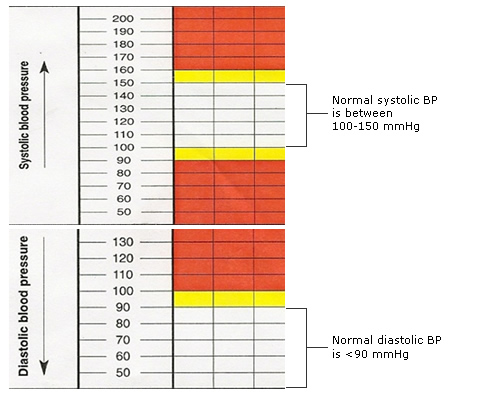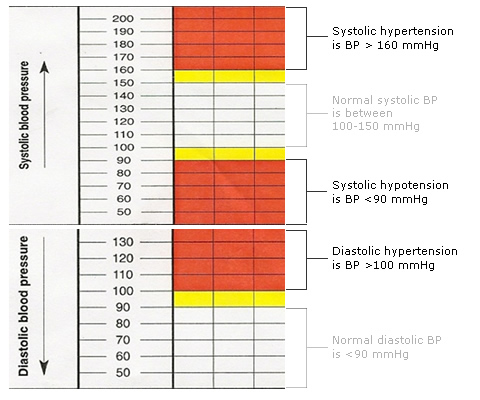A falling BP should be regarded as a late sign of deterioration
(peri-mortem) because pregnant women can lose up to 30-40% of
their circulating blood volume with no change to their blood
pressure.
Using the correct cuff size for the woman is important for the accuracy of blood pressure recordings, especially in obese women who need a large diameter cuff. The cuff should cover at least two-thirds of the upper arm.
All pregnant women with a systolic blood pressure of 150 mmHg or more and/or a diastolic above 100mmHg or more require antihypertensive treatment.
Electronic recordings of blood pressure can underestimate readings by up to 5%.
Question 1: What is the normal blood pressure (BP) range for the obstetric patient?

A falling BP should be regarded as a late sign of deterioration
(peri-mortem) because pregnant women can lose up to 30-40% of
their circulating blood volume with no change to their blood
pressure.
Using the correct cuff size for the woman is important for the accuracy of blood pressure recordings, especially in obese women who need a large diameter cuff. The cuff should cover at least two-thirds of the upper arm.
All pregnant women with a systolic blood pressure of 150 mmHg or more and/or a diastolic above 100mmHg or more require antihypertensive treatment.
Electronic recordings of blood pressure can underestimate readings by up to 5%.
Question 1: What is the normal blood pressure (BP) range for the obstetric patient?
Question 2: When does BP enter the RED areas?

A falling BP should be regarded as a late sign of deterioration
(peri-mortem) because pregnant women can lose up to 30-40% of
their circulating blood volume with no change to their blood
pressure.
Using the correct cuff size for the woman is important for the accuracy of blood pressure recordings, especially in obese women who need a large diameter cuff. The cuff should cover at least two-thirds of the upper arm.
All pregnant women with a systolic blood pressure of 150 mmHg or more and/or a diastolic above 100mmHg or more require antihypertensive treatment.
Electronic recordings of blood pressure can underestimate readings by up to 5%.
Question 1: What is the normal blood pressure (BP) range for the obstetric patient?
Question 2: When does BP enter the RED areas?
